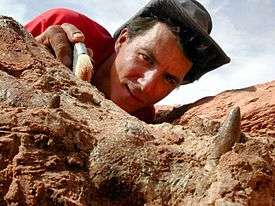Paul Sereno
Paul Callistus Sereno (born October 11, 1957) is a professor of paleontology at the University of Chicago and a National Geographic "explorer-in-residence" who has discovered several new dinosaur species on several continents, including at sites in Inner Mongolia, Argentina, Morocco and Niger.[1] One of his most widely publicized discoveries is that of a nearly complete specimen of Sarcosuchus imperator — popularly known as SuperCroc — at Gadoufaoua in the Tenere desert of Niger.
Paul C. Sereno | |
|---|---|
 At his laboratory in 2010 | |
| Born | October 11, 1957 Aurora, Illinois, USA |
| Nationality | American |
| Alma mater | Northern Illinois University (B.S., Biological Sciences, 1979) Columbia University (M.A., Vertebrate Paleontology, 1981; M. Phil., Geological Sciences, 1981; Ph.D., Geological Sciences, 1987) |
| Known for | Discoveries in paleontology; founder of Project Exploration |
| Scientific career | |
| Fields | Paleontology (vertebrate) |
| Institutions | University of Chicago |
| Doctoral students | Jeffrey A. Wilson |
| Author abbrev. (zoology) | Sereno |
Biography
Youth and education
The son of a mail carrier[2] and an art teacher at Prairie Elementary, Sereno grew up in Naperville, Illinois and graduated from Naperville Central High School. He was then educated at Northern Illinois University (B.S., Biological Sciences, 1979) and Columbia University (M.A., Vertebrate Paleontology, 1981; M. Phil., Geological Sciences, 1981; Ph.D., Geological Sciences, 1987).
Career
Sereno was named one of People magazine's 50 Most Beautiful People (1997).[3]
Sereno co-founded Project Exploration, a non-profit science education organization to encourage city kids to pursue careers in science. 1997-12-05 He appears in the 2009 DVD Dinosaur Discoveries, featuring classic segments of CBS anchorman Walter Cronkite as the host, which aired on A&E in 1991. It was later re-shown on the Disney Channel until the late 1990s.
On August 14, 2008, it was revealed that Sereno had uncovered a large Stone Age cemetery at Gobero in the Nigerien Sahara, remnants of a people who lived from 10,000 to 5,000 years ago on the edge of what was then a large lake. The National Geographic documentary, Skeletons of the Sahara was made about this discovery and premiered in 2013. [4][5][6]
Fossil species described by Sereno or his team
|
Dinosaurs
|
|

Documentaries featuring Sereno and his discoveries
In addition to his many discoveries in the field, public communication has been a big part of Sereno's career.
| Year | Title | Producer | Featured Fossils (Sites) |
|---|---|---|---|
| 1991 | At the Forefront | Kurtis Productions, Ltd., PBS | |
| 1992 | Fragments of Time | New Explorers, PBS | Eoraptor (Argentina) |
| 1992 | The Dinosaurs! - Flesh on the Bones | WHYY-TV, PBS | Herrerasaurus (Argentina) |
| 1993 | The Next Generation, 1% Inspiration | WNET, PBS | |
| 1994 | Skeletons in the Sand | New Explorers, PBS | (Niger) |
| 1995 | Paleoworld - African Graveyard, Part I: Hunting Dinosaurs | The Learning Channel | (Morocco) |
| 1995 | Paleoworld - African Graveyard, Part II: Discovering Dinosaurs | The Learning Channel | (Morocco) |
| 1996 | Paleoworld - Flesh on the Bones | The Learning Channel | Deltadromeus, Carcharodontosaurus (Morocco) |
| 1997 | Beyond T-Rex | Discovery Channel | Carcharodontosaurus (Morocco) |
| 1998 | Colossal Claw | National Geographic Explorer | Suchomimus (Sahara) |
| 1998 | Dinosaur Fever | National Geographic Explorer | sauropods (Niger) |
| 1999 | Africa's Dinosaur Giants | National Geographic Explorer | Jobaria (Niger) |
| 2001 | SuperCroc | NBC/NGC | Sarcosuchus |
| 2006 | Sky Monsters | NGC | pterosaur (Niger) |
| 2009 | Bizarre Dinos | NGC | Nigersaurus, Raptorex, Mykocephale |
| 2009 | When Crocs Ate Dinosaurs | NGChannel | BoarCroc, PancakeCroc, DuckCroc, DogCroc, RatCroc (Sahara, Australia) |
| 2013 | Skeletons of the Sahara | NOVA-NGTelevision | humans (Gobero, Niger) |
| 2014 | Bigger than T. rex | NOVA-NGTelevision | Spinosaurus (Morocco) |
References
- Briggs, Helen (12 December 2007). "New meat-eating dinosaur unveiled" (Web). News article about; Carcharodontosaurus iguidensis was one of the largest meat-eaters that ever lived. BBC News. Retrieved 2007-12-15.
- Spalding, D.A.E., 1993, Dinosaur Hunters: 150 years of extraordinary discoveries, Key Porter Books, Toronto, p. 284
- "Most Beautiful: Paul Sereno". People. 1997-12-05. Archived from the original on 2013-12-02. Retrieved 2013-11-24.
- Dell'Amore, Christine (14 August 2008). "Ancient Cemetery Found; Brings "Green Sahara" to Life" (Web). News article about; Dinosaur hunters have stumbled across the largest and oldest Stone Age cemetery in the Sahara desert. National Geographic News. Retrieved 2008-08-15.
- Gwin, Peter (September 2008). "Green Sahara" (Web). Feature story about; Lost Tribes of the Green Sahara - How a dinosaur hunter uncovered the Sahara's strangest Stone Age graveyard. National Geographic. Retrieved 2008-08-15.
- "Skeletons of the Sahara" (Web). PBS. Retrieved 2013-08-24.
External links
- Paulsereno.org: official Paul Sereno website
- TED talk by Paul Sereno on YouTube What can fossils teach us?
- TEDX talk by Paul Sereno on YouTube Dinosaurs on Drifting Continents
- Digging up dinosaurs, TED